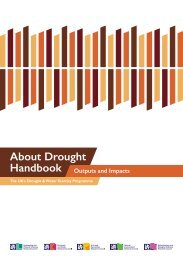DelegatePack_DroughtConference_20-21March2019
You also want an ePaper? Increase the reach of your titles
YUMPU automatically turns print PDFs into web optimized ePapers that Google loves.
Speakers<br />
Day 1: Plenary – The Pichette Auditorium continued<br />
Massimiliano Pasqui CNR (Italian National Research Council)<br />
A customizable drought monitoring and seasonal forecasting service to support different users’<br />
needs<br />
Massimiliano Pasqui is a climate scientist whose main interests are numerical modelling in support of weather<br />
forecasts, climate data analysis, seasonal forecast predictability and climate change impacts. He participates in a<br />
number of national and international projects in these fields. He is the author of numerous scientific papers on<br />
international journals/books on atmospheric science and climate change mechanisms and impacts in the<br />
Mediterranean basin and Africa. In the last decade he has been engaged as a contract professor in meteorology,<br />
numerical modelling and climatology courses at several Italian universities.<br />
Bramha Dutt Vishwakarma University of Bristol<br />
Novel metric for water stress from the Gravity Recovery & Climate Experiment (GRACE) satellite<br />
mission<br />
The GRACE satellite mission recorded time-variability in Earth’s gravity for more than a decade, which can be directly<br />
related to changes in water stored near the surface of the Earth. GRACE maps of water mass change are available at<br />
monthly time scale and have been used to validate hydrology models, close regional water budgets, estimate<br />
groundwater changes and map water stress. Usually the GRACE time series is decomposed into a linear trend and a<br />
periodic signal and then the magnitude of the trend is used to infer the severity of water mass in a region. In this<br />
study we show that such an approach is misleading because catchment scale hydrology also contains inter-annual<br />
signals with decadal frequencies that are also recorded by GRACE. Since the quality-controlled GRACE record is only<br />
about 13 years long, the long wavelength inter-annual signal cannot be co-estimated and will contaminate estimates of<br />
linear trend. Furthermore, the inter-annual behaviour of each catchment is different and, therefore, a catchment<br />
should not be evaluated against other catchments but with respect to its natural variability. Therefore, to quantify<br />
water-stress comprehensively, we propose a novel metric for water stress that uses GRACE trend and inter-annual<br />
variability from a calibrated 62-years-long hydrology model time series. We obtain a global water stress map that<br />
differs markedly from previous GRACE assessments. We find that more than 1.5 billion people in 39 river catchments<br />
are facing severe water stress and this number will rise by 50% in <strong>20</strong>25 if current trends continue.<br />
Day 1: Parallel Session 1 Climatology and Hydrology – Pichette Auditorium<br />
Jamie Hannaford presenting for Katie Smith CEH<br />
Reconstructing historic flow data to inform management<br />
Hydrological models can provide estimates of streamflow pre- and post- observations, which enable greater<br />
understanding of past hydrological behaviour and potential futures. We outline a new multi-objective calibration<br />
method which was derived and tested for 303 catchments in the UK. The calibrations were used to reconstruct river<br />
flows back to 1891 to provide a much longer view of past hydrological variability given the brevity of most UK river<br />
flow records which commenced post-1960. This work provides an exemplar framework for calibrating catchment<br />
models for use in multiple applications. The ~125 year spatially and temporally consistent reconstructed flow dataset<br />
derived for this study will also allow comprehensive quantitative assessments of past UK drought events, as well as<br />
long-term analyses of hydrological variability that have not been previously possible. This will allow water resource<br />
managers to better plan for extreme events, and build more resilient systems for the future.<br />
Lucy Barker CEH<br />
How severe were historic hydrological droughts in the UK? Insights from a systematic<br />
characterisation and ranking of events back to 1891<br />
The relative shortness of river flow records in the UK means that it is not possible to characterise hydrological<br />
droughts prior to the 1960s in many places across the country. We know from individual long river flow records,<br />
regional flow reconstructions and qualitative data that severe hydrological droughts occurred in the late 19th and<br />
early <strong>20</strong>th Century; but until recently it hasn’t been possible to identify and characterise these droughts across the<br />
UK. New daily river flow reconstructions for 303 catchments across the UK, dating back to 1891 have enabled<br />
national scale, drought identification and characterisation. For 108 near-natural catchments across the UK, using the<br />
Standardised Streamflow Index for accumulation periods of 3 and 12 months, hydrological drought events over<br />
~125 years from 1891 to <strong>20</strong>15 have been systematically identified, characterised and ranked. Extracted events were<br />
ranked according to four characteristics: duration, accumulated deficit, mean deficit and maximum intensity in order<br />
to assess how the events compare when different aspects of severity were considered. These results provide an<br />
unprecedented view of drought severity in the UK, shedding light on those events outside of the observed period<br />
(e.g. the early 19<strong>20</strong>s) and that are poorly documented in qualitative sources (for example the droughts of the 1940s).<br />
This extended understanding of past droughts is crucial to inform the planning and management of future events,<br />
aiding the development of scenarios outside the range of those seen in observed data and providing benchmarks<br />
against which to compare current and future events.




